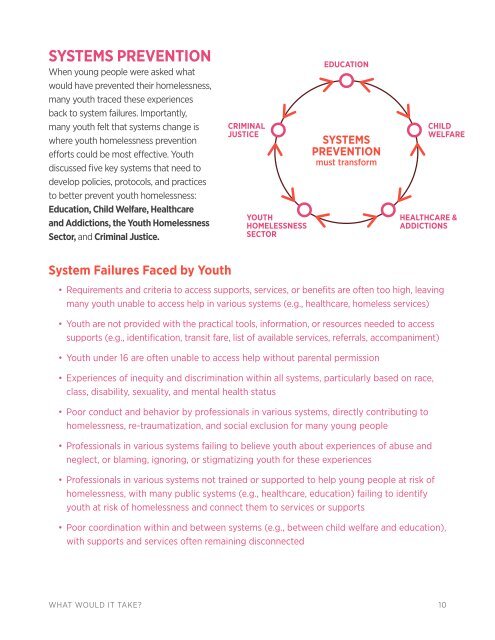COH-AWH-What_Would_it_Take
Create successful ePaper yourself
Turn your PDF publications into a flip-book with our unique Google optimized e-Paper software.
SYSTEMS PREVENTION<br />
When young people were asked what<br />
would have prevented their homelessness,<br />
many youth traced these experiences<br />
back to system failures. Importantly,<br />
many youth felt that systems change is<br />
where youth homelessness prevention<br />
efforts could be most effective. Youth<br />
discussed five key systems that need to<br />
develop policies, protocols, and practices<br />
to better prevent youth homelessness:<br />
Education, Child Welfare, Healthcare<br />
and Addictions, the Youth Homelessness<br />
Sector, and Criminal Justice.<br />
CRIMINAL<br />
JUSTICE<br />
YOUTH<br />
HOMELESSNESS<br />
SECTOR<br />
EDUCATION<br />
SYSTEMS<br />
PREVENTION<br />
must transform<br />
CHILD<br />
WELFARE<br />
HEALTHCARE &<br />
ADDICTIONS<br />
System Failures Faced by Youth<br />
• Requirements and cr<strong>it</strong>eria to access supports, services, or benef<strong>it</strong>s are often too high, leaving<br />
many youth unable to access help in various systems (e.g., healthcare, homeless services)<br />
• Youth are not provided w<strong>it</strong>h the practical tools, information, or resources needed to access<br />
supports (e.g., identification, trans<strong>it</strong> fare, list of available services, referrals, accompaniment)<br />
• Youth under 16 are often unable to access help w<strong>it</strong>hout parental permission<br />
• Experiences of inequ<strong>it</strong>y and discrimination w<strong>it</strong>hin all systems, particularly based on race,<br />
class, disabil<strong>it</strong>y, sexual<strong>it</strong>y, and mental health status<br />
• Poor conduct and behavior by professionals in various systems, directly contributing to<br />
homelessness, re-traumatization, and social exclusion for many young people<br />
• Professionals in various systems failing to believe youth about experiences of abuse and<br />
neglect, or blaming, ignoring, or stigmatizing youth for these experiences<br />
• Professionals in various systems not trained or supported to help young people at risk of<br />
homelessness, w<strong>it</strong>h many public systems (e.g., healthcare, education) failing to identify<br />
youth at risk of homelessness and connect them to services or supports<br />
• Poor coordination w<strong>it</strong>hin and between systems (e.g., between child welfare and education),<br />
w<strong>it</strong>h supports and services often remaining disconnected<br />
WHAT WOULD IT TAKE? 10
















